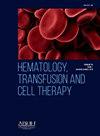HEMOPHILIA: ADVANCES IN TREATMENTS
IF 1.8
Q3 HEMATOLOGY
引用次数: 0
Abstract
Introduction
Hemophilia is an X-linked recessive disorder. It is divided into two different subtypes; hemophilia A (HA) and B (HB), which result from the deficiency or complete absence of clotting factors VIII (FVIII) and IX (FIX) respectively. Current management of HA and HB includes prophylactic factor replacement1. Neutralising antibodies, as inhibitors, can develop against the infused factor and that can complicate the management of hemophilia patients. If inhibitors develop, immune tolerance induction can potentially promote tolerance to exogenous FVIII or FIX, and bypassing agents (BPAs) such as recombinant factor VIIa (rFVIIa) and activated prothrombin complex concentrates (aPCC) can be used to circumvent factor use. Inhibitor development impacts negatively upon quality of life and treatment compliance, highlighting the need for improved therapies. Several novel pharmacological therapies developed for hemophilia aim to rebalance the clotting cascade. These therapies utilise a range of different mechanisms, namely: the extension of the circulating half-life of standard recombinant factors; the mimicking of factor VIII cofactor activity; rebalancing of coagulation through targeting of natural anticoagulants such as antithrombin and tissue factor pathway inhibitor; and inducing the production of endogenous factors with gene therapy.
Discussion
Extended half‐life products involves fusing FVIII or FIX to a protein with a long half-life. Albumin and the constant region (Fc) of IgG have long plasma half-lives as they bind to the neonatal Fc receptor, which is critical for the endogenous recycling of both IgG and albumin. Another method is PEGylation, where one or more PEG chains are covalently linked to rFVIII or rFIX. PEG chains interfere with the recombinant factors binding to their clearance receptors, thereby prolonging circulating half-life.
Emicizumab, a recombinant humanised bispecific IgG antibody, mimics the cofactor function of the missing FVIII in HA. It simultaneously binds activated FIX (FIXa) and factor X (FX), bringing them into spatial proximity to promote FIXa-catalysed FX activation, thereby restoring haemostasis.
Fitusiran, a novel therapy applicable to both HA and HB, consists of the amino acid, N-Acetyl- galactosamine, the ligand of the hepatic asialo-glycoprotein receptors, conjugated to a synthetic siRNA. It targets and degrades a region of the SERPINC1 gene mRNA, preventing antithrombin production and enhancing thrombin generation. Antithrombin is a potent anticoagulant which inactivates FIXa, activated factor X (FXa) and activated factor II (FIIa/thrombin). Therefore, fitusiran can correct the coagulation imbalance and prevent the bleeding phenotype.
Concizumab is an IgG4 monoclonal antibody targeting tissue factor pathway inhibitor (TFPI). It presents an alternative therapy for HA and HB patients, both with and without inhibitors. TFPI is a coagulation inhibitor. It limits coagulation during the initiation of the coagulation cascade through inhibition of the tissue factor-activated factor VII (TF-FVIIa) complex and through FXa inhibition.
Gene therapy presents a novel and effective treatment modality for hemophilia, potentially bypassing complications of other therapies. Gene therapy regimens consist of single infusions of a viral vector, which result in transduction of a gene coding for the deficient factor into patient hepatocytes. Current gene therapy regimens for hemophilia predominantly utilise adeno-associated virus (AAV) vectors to deliver the required gene.
Conclusion
Current factor replacement poses numerous issues, resulting in poor adherence and reduced QoL. Inhibitor development presents a key limitation to factor replacement. EHL products, emicizumab, fitusiran, and concizumab (summarised in appear effective in patients with and without inhibitors, and their longer half-lives enable less frequent injections.
求助全文
约1分钟内获得全文
求助全文
来源期刊

Hematology, Transfusion and Cell Therapy
Multiple-
CiteScore
2.40
自引率
4.80%
发文量
1419
审稿时长
30 weeks
 求助内容:
求助内容: 应助结果提醒方式:
应助结果提醒方式:


